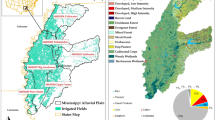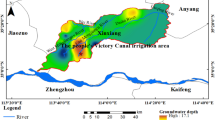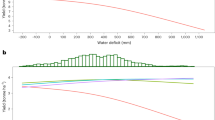Abstract
The Po Plain in northern Italy is a critical agricultural region and one of the largest water users in the European Union. Recent dry conditions have put future water resource availability into question. This study examines spatio-temporal variations in groundwater storage observed by the Gravity Recovery and Climate Experiment satellites and more than 1,000 groundwater wells from 2002 to 2022. We find that the rate of groundwater storage decline more than doubled from 2015 to 2022 as compared to the 2002–2022 rate. We also show that seasonal and long-term groundwater availability is strongly influenced by irrigation activities. Groundwater storage in irrigated areas is highly correlated to snow accumulation in the Alps and shows more stability as compared to non-irrigated areas, which experience dramatic declines during drought years. This indicates that inefficient irrigation practice, using water largely supplied by snowmelt, recharges underground aquifers and helps maintain high water tables, making aquifers underlying irrigated farmland resilient to the negative consequences of drought. These findings can help guide climate-driven adaptations to irrigation systems that account for the impact on groundwater recharge.
This is a preview of subscription content, access via your institution
Access options
Subscribe to this journal
Receive 12 digital issues and online access to articles
$119.00 per year
only $9.92 per issue
Buy this article
- Purchase on SpringerLink
- Instant access to full article PDF
Prices may be subject to local taxes which are calculated during checkout





Similar content being viewed by others
Data availability
GRACE JPL mascon solutions can be downloaded from https://podaac.jpl.nasa.gov/dataset/TELLUS_GRAC-GRFO_MASCON_CRI_GRID_RL06.1_V3. GLDAS models VIC, Noah and CLSM can be downloaded from https://disc.gsfc.nasa.gov/datasets?keywords=GLDAS. GLEAM4 can be downloaded via SFTP at https://www.gleam.eu. ERA5-Land can be downloaded from https://cds.climate.copernicus.eu/cdsapp#!/dataset/10.24381/cds.68d2bb30?tab=form. SPEI can be downloaded from https://spei.csic.es/map/. Monthly Po River discharge data provided by D. Zanchetin are available via Zenodo at https://doi.org/10.5281/zenodo.7225699 (ref. 63). Monthly precipitation is available from NASA’s IMERG project at https://disc.gsfc.nasa.gov/datasets/GPM_3IMERGM_07/summary?keywords=%22IMERG%20final%22. SWE is provided by the Meteorological Reanalysis Italian Dataset at https://merida.rse-web.it. Monthly seasonal mean groundwater levels and trends for 1,024 groundwater wells across the northern Italian plains are available via Zenodo at https://doi.org/10.5281/zenodo.14013762 (ref. 66).
Code availability
All data were processed in MATLAB. Wavelet software was provided by C. Torrence and G. Compo and is available at http://atoc.colorado.edu/research/wavelets/.
References
Immerzeel, W. W. et al. Importance and vulnerability of the world’s water towers. Nature 577, 364–369 (2020).
Siebert, S. et al. A global data set of the extent of irrigated land from 1900 to 2005. Hydrol. Earth Syst. Sci. 19, 1521–1545 (2015).
Siebert, S. et al. Groundwater use for irrigation—a global inventory. Hydrol. Earth Syst. Sci. 14, 1863–1880 (2010).
Mehta, P. et al. Half of twenty-first century global irrigation expansion has been in water-stressed regions. Nat. Water 2, 254–261 (2024).
Scanlon, B. R. et al. Global water resources and the role of groundwater in a resilient water future. Nat. Rev. Earth Environ. 4, 87–101 (2023).
Koster, D. et al. Regions of strong coupling between soil moisture and precipitation. Science 305, 1138–1140 (2004).
McDermid, S. et al. Irrigation in the Earth system. Nat. Rev. Earth Environ. 4, 435–453 (2023).
Qin, Y. et al. Agricultural risks from changing snowmelt. Nat. Clim. Change 10, 459–465 (2020).
Borin, M. A wise irrigation to contribute to integrated water resource management. Ital. J. Agrometeorol. 10, 5–19 (2023).
Zucaro, R. Atlante nazionale dell’irrigazione ‘National atlas of irrigation’ (INEA, 2011).
Colombo, N. et al. Long-term trend of snow water equivalent in the Italian Alps. J. Hydrol. 614, 128532 (2022).
Montanari, A. et al. Why the 2022 Po River drought is the worst in the past two centuries. Sci. Adv. 9, eadg8304 (2023).
Avanzi, F. et al. Winter snow deficit was a harbinger of summer 2022 socio-hydrologic drought in the Po Basin, Italy. Commun. Earth Environ. 5, 64 (2024).
IPCC Climate Change 2021: The Physical Science Basis (Cambridge Univ. Press, 2021).
Spinoni, J. et al. Future global meteorological drought hot spots: a study based on CORDEX data. J. Clim. 33, 3635–3661 (2020).
Qin, Y. et al. Snowmelt risk telecouplings for irrigated agriculture. Nat. Clim. Change 12, 1007–1015 (2022).
Brussolo, E. et al. Aquifer recharge in the Piedmont Alpine zone: historical trends and future scenarios. Hydrol. Earth Syst. Sci. 26, 407–427 (2022).
ISTAT Utilizzo e qualità della risorsa idrica in Italia (Istat, 2019); https://www.istat.it/produzione-editoriale/utilizzo-e-qualita-della-risorsa-idrica-in-italia/
Rossi, M., Donnini, M. & Beddini, G. Nationwide groundwater recharge evaluation for a sustainable water withdrawal over Italy. J. Hydrol.: Reg. Stud. 43, 101172 (2022).
Lasagna, M., Mancini, S. & De Luca, D. A. Aquifer protection from overexploitation: example of actions and mitigation activities used in the Maggiore Valley (Asti Province, NW Italy). GEAM. Geoing. Ambient. Mineraria 156, 30–38 (2019).
Sartirana, D. et al. Quantifying groundwater infiltrations into subway lines and underground car parks using MODFLOW-USG. Water 14, 4130 (2022).
Bellafiore, D. et al. Saltwater intrusion in a Mediterranean delta under a changing climate. J. Geophys. Res. 126, e2020JC016437 (2021).
Teatini, P., Ferronato, M., Gambolati, G., Bertoni, W. & Gonella, M. A century of land subsidence in Ravenna, Italy. Environ. Geol. 47, 831–846 (2005).
Teatini, P., Ferronato, M., Gambolati, G. & Gonella, M. Groundwater pumping and land subsidence in the Emilia-Romagna coastland, Italy: modeling the past occurrence and the future trend. Water Resour. Res. 42, W01406 (2006).
Carminati, E. & Martinelli, G. Subsidence rates in the Po Plain, northern Italy: the relative impact of natural and anthropogenic causation. Eng. Geol. 66, 241–255 (2002).
Rotiroti, M. et al. The effects of irrigation on groundwater quality and quantity in a human-modified hydro-system: the Oglio River basin, Po Plain, northern Italy. Sci. Total Environ. 672, 342–356 (2019).
Bonaldo, D. et al. The summer 2022 drought: a taste of future climate for the Po valley (Italy)? Reg. Environ. Change 23, 1 (2022).
Colombo, N. et al. Unprecedented snow-drought conditions in the Italian Alps during the early 2020s. Environ. Res. Lett. 18, 074014 (2023).
van Tiel, M. et al. Cryosphere–groundwater connectivity is a missing link in the mountain water cycle. Nat. Water 2, 624–637 (2024).
Van Lanen, H. A. J., Wanders, N., Tallaksen, L. M. & Van Loon, A. F. Hydrological drought across the world: impact of climate and physical catchment structure. Hydrol. Earth Syst. Sci. 17, 1715–1732 (2013).
Tapley, B. D., Bettadpur, S., Ries, J. C., Thompson, P. F. & Watkins, M. M. GRACE measurements of mass variability in the Earth system. Science 305, 503–505 (2004).
Rodell, M., Velicogna, I. & Famiglietti, J. S. Satellite-based estimates of groundwater depletion in India. Nature 460, 999–1002 (2009).
Torrence, C. & Compo, G. P. A practical guide to wavelet analysis. Bull. Am. Meteorol. Soc. 79, 61–78 (1998).
Vicente-Serrano, S. M., Beguería, S. & López-Moreno, J. I. The Standardized Precipitation Evapotranspiration Index—SPEI. J. Clim. 23, 1696–1718 (2010).
Beguería, S., Vicente-Serrano, S. M., Reig-Garcia, F., & Latorre Garcés, B. SPEIbase v.2.9 DIGITAL.CSIC v. 2.9 (DIGITAL.CSIC, 2023).
Giuliano, G. Ground water in the Po basin: some problems relating to its use and protection. Sci. Total Environ. 171, 17–27 (1995).
Atlante dell’agricoltura italiana - 6° Censimento generale dell’agricoltura [Atlas of Italian Agriculture - 6th General Census of Agriculture] (Istat, 2014).
Humphrey, V., Rodell, M. & Eicker, A. Using satellite-based terrestrial water storage data: a review. Surv. Geophys. 44, 1489–1517 (2023).
Giustini, F., Brilli, M. & Patera, A. Mapping oxygen stable isotopes of precipitation in Italy. J. Hydrol.: Reg. Stud. 8, 162–181 (2016).
Wilson, J. L. and Guan, H. in Groundwater Recharge in a Desert Environment: The Southwestern United States (eds Hogan, J. F. et al.), 113–137 (AGU, 2004); https://doi.org/10.1029/009WSA08
Masetti, M. et al. Impact of a storm-water infiltration basin on the recharge dynamics in a highly permeable aquifer. Water Resour. Manag. 30, 149–165 (2016).
Ministero delle Politiche Agricole Alimentari e Forestali. L’agricoltura nel distretto idrografico padano: Contributo tematico al Piano di Gestione del Distretto Idrografico Padano (Autorità di bacino del fiume Po, 2010).
Directive 2000/60/EC of the European Parliament and of the Council Establishing a Framework for Community Action in the Field of Water Policy (European Council, 2000).
Grafton, R. Q. et al. The paradox of irrigation efficiency. Science 361, 748–750 (2018).
Xanke, J. & Liesch, T. Quantification and possible causes of declining groundwater resources in the Euro-Mediterranean region from 2003 to 2020. Hydrogeol. J. 30, 379–400 (2022).
Masseroni, D. et al. The 63-year changes in annual streamflow volumes across Europe with a focus on the Mediterranean basin. Hydrol. Earth Syst. Sci. 25, 5589–5601 (2020).
Cowherd, M., Leung, R. & Girotto, M. Evolution of global snow drought characteristics from 1850 to 2100. Environ. Res. Lett. 18, 064043 (2023).
Watkins, M. M., Wiese, D. N., Yuan, D.-N., Boening, C. & Landerer, F. W. Improved methods for observing Earth’s time variable mass distribution with GRACE using spherical cap mascons. J. Geophys. Res: Solid Earth 120, 2648–2671 (2015).
Wiese, D. N., Landerer, F. W. & Watkins, M. M. Quantifying and reducing leakage errors in the JPL RL05M GRACE Mascon solution. Water Resour. Res. 52, 7490–7502 (2016).
Wiese, D. N., Yuan, D.-N., Boening, C., Landerer, F. W. & Watkins, M. M. JPL GRACE Mascon Ocean, Ice, and Hydrology Equivalent Water Height CRI Filtered. Ver. RL06Mv01 (PO.DAAC, 2018).
Landerer, F. W. et al. Extending the global mass change data record: GRACE follow‐on instrument and science data performance. Geophys. Res. Lett. 47, e2020GL088306 (2020).
Li, B., Beaudoing, H. and Rodell, M. NASA/GSFC/HSL. GLDAS Catchment Land Surface Model L4 Monthly 1.0 x 1.0 Degree V2.1 (GES DISC, 2020); https://doi.org/10.5067/FOUXNLXFAZNY
Rodell, M. et al. The global land data assimilation system. Bull. Am. Meteorol. Soc. 85, 381–394 (2004).
Beaudoing, H. and Rodell, M. NASA/GSFC/HSL. GLDAS Noah Land Surface Model L4 Monthly 1.0 x 1.0 Degree V2.1 (GES DISC, 2020); https://doi.org/10.5067/LWTYSMP3VM5Z
Muñoz-Sabater, J. et al. ERA5-Land: a state-of-the-art global reanalysis dataset for land applications. Earth Syst. Sci. Data 13, 4349–4383 (2021).
Miralles, D. G. et al. Global land-surface evaporation estimated from satellite-based observations. Hydrol. Earth Syst. Sci. 15, 453–469 (2011).
Beaudoing, H. and Rodell, M. NASA/GSFC/HSL. GLDAS VIC Land Surface Model L4 Monthly 1.0 x 1.0 Degree V2.1 (GES DISC, 2020); https://doi.org/10.5067/VWTH7S6218SG
Woessner, W. W. & Poeter, E. P. Hydrogeologic Properties of Earth Materials and Principles of Groundwater Flow (The Groundwater Project, 2020).
Bonomi, T. Database development and 3D modeling of textural variations in heterogeneous, unconsolidated aquifer media: application to the Milan plain. Comput. Geosci. 35, 134–145 (2009).
Bonomi, T., Fumagalli, L., Rotiroti, M., Bellani, A. & Cavallin, A. The hydrogeological well database TANGRAM©: a tool for data processing to support groundwater assessment. Ital. J. Groundw. 3, 35–45 (2014).
ISPRA Dati provenienti dall’Archivio nazionale delle indagini nel sottosuolo ai sensi della Legge 464/84, ISPRA - Dipartimento per il Servizio Geologico d’Italia – Servizio GEO-APP (ISPRA, 2024).
Smith, R. Aquifer stress history contributes to historic shift in subsidence in the San Joaquin Valley, California. Water Resour. Res. 59, e2023WR035804 (2023).
Zanchetin, D. Monthly discharge of Po River at Pontelagoscuro. Zenodo https://doi.org/10.5281/zenodo.7225699 (2022).
Bonanno, R., Lacavalla, M. & Sperati, S. A new high-resolution meteorological reanalysis Italian dataset: MERIDA. Q. J. R. Meteorol. Soc. 145, 1756–1779 (2019).
Martinelli, G. et al. Nitrate sources, accumulation and reduction in groundwater from northern Italy: insights provided by a nitrate and boron isotopic database. Applied Geochem. 91, 23–35 (2018).
Carlson, G., Girotto, M., Wilder, A. & Massari, C. Groundwater level seasonal behavior and trends in wells across the northern Italian plains. Zenodo https://doi.org/10.5281/zenodo.14013762 (2024).
Acknowledgements
We thank the following monitoring agencies: Agenzia Regionale per la Protezione dell’Ambiente (ARPA) Lombardia, L’Agenzia regionale per la prevenzione, l’ambiente e l’energia dell’Emilia Romagna (ARPAE), Agenzia Regionale per la Prevenzione e Protezione Ambientale del Veneto (ARPAV) and Agenzia Regionale per la Protezione Ambientale (ARPA) Piemonte for providing the in situ groundwater observation well time series and lake-level change time series. NASA grants 80NSSC20K1240 and 80NSSC22K1831 and the Hellman Fellows Fund supported G.C. and M.G., European Space Agency (ESA) grant 4000136272/21/I-EF supported C.M. and the Historically Black Colleges and Universities-Berkeley Environmental Scholars for Change Program supported D.W.
Author information
Authors and Affiliations
Contributions
G.C., M.G. and C.M. conceived and designed the experiments. G.C. performed the experiments. G.C., M.G., C.M., M.R., T.B., E.P. and D.W. analysed the data. G.C., M.G., C.M., M.R., T.B. and A.W. contributed materials and analysis tools. G.C. led the writing of the paper with all authors making contributions to the writing and editing process.
Corresponding author
Ethics declarations
Competing interests
The authors declare no competing interests.
Peer review
Peer review information
Nature Water thanks Jenna Dohman, David Ketchum and the other, anonymous, reviewer(s) for their contribution to the peer review of this work.
Additional information
Publisher’s note Springer Nature remains neutral with regard to jurisdictional claims in published maps and institutional affiliations.
Extended data
Extended Data Fig. 1 Number of observations used to calculate ∆GWS for each time step for each time series in Fig. 5.
The High Plain and Low Plain (dark blue and orange, respectively) correspond to ∆GWS time series in Fig. 5a. Lombardia irrigated and Lombardia not irrigated (yellow and purple, respectively) correspond to the time series in Fig. 5b. Veneto and Piemonte (green and purple, respectively) correspond to the time series in Fig. 5c and Emilia Romagna (red) correspnds to the time series in Fig. 5d.
Rights and permissions
Springer Nature or its licensor (e.g. a society or other partner) holds exclusive rights to this article under a publishing agreement with the author(s) or other rightsholder(s); author self-archiving of the accepted manuscript version of this article is solely governed by the terms of such publishing agreement and applicable law.
About this article
Cite this article
Carlson, G., Massari, C., Rotiroti, M. et al. Intensive irrigation buffers groundwater declines in key European breadbasket. Nat Water 3, 683–692 (2025). https://doi.org/10.1038/s44221-025-00445-4
Received:
Accepted:
Published:
Issue date:
DOI: https://doi.org/10.1038/s44221-025-00445-4



